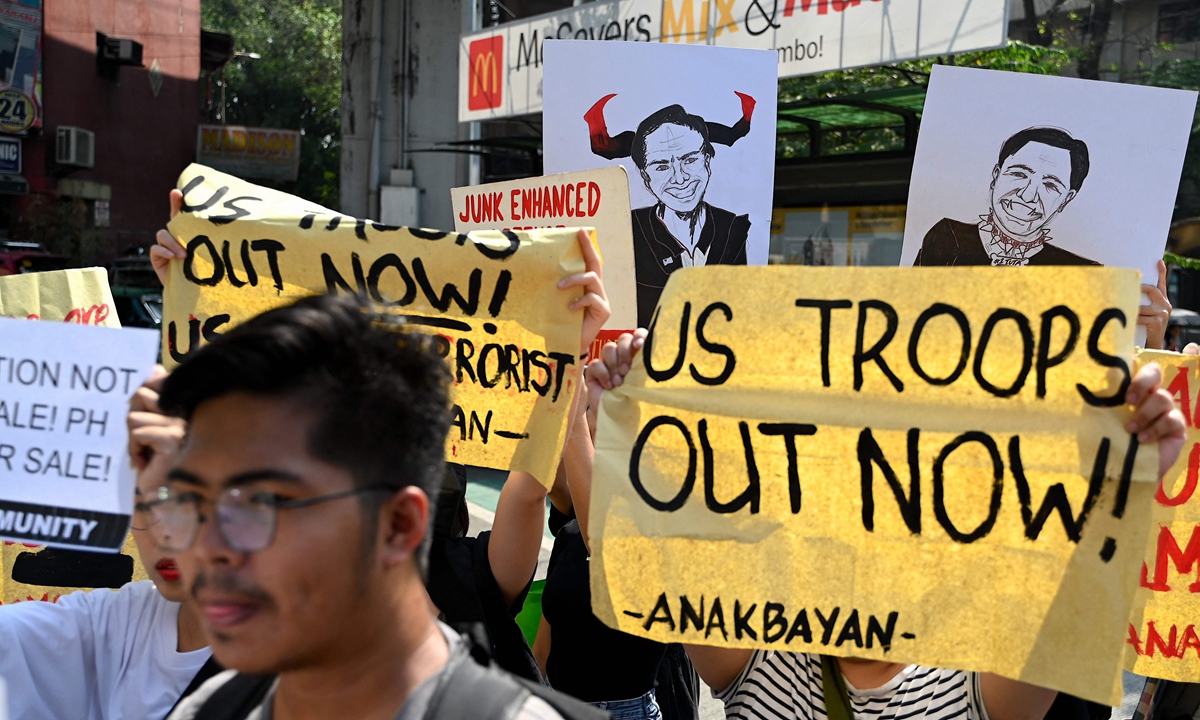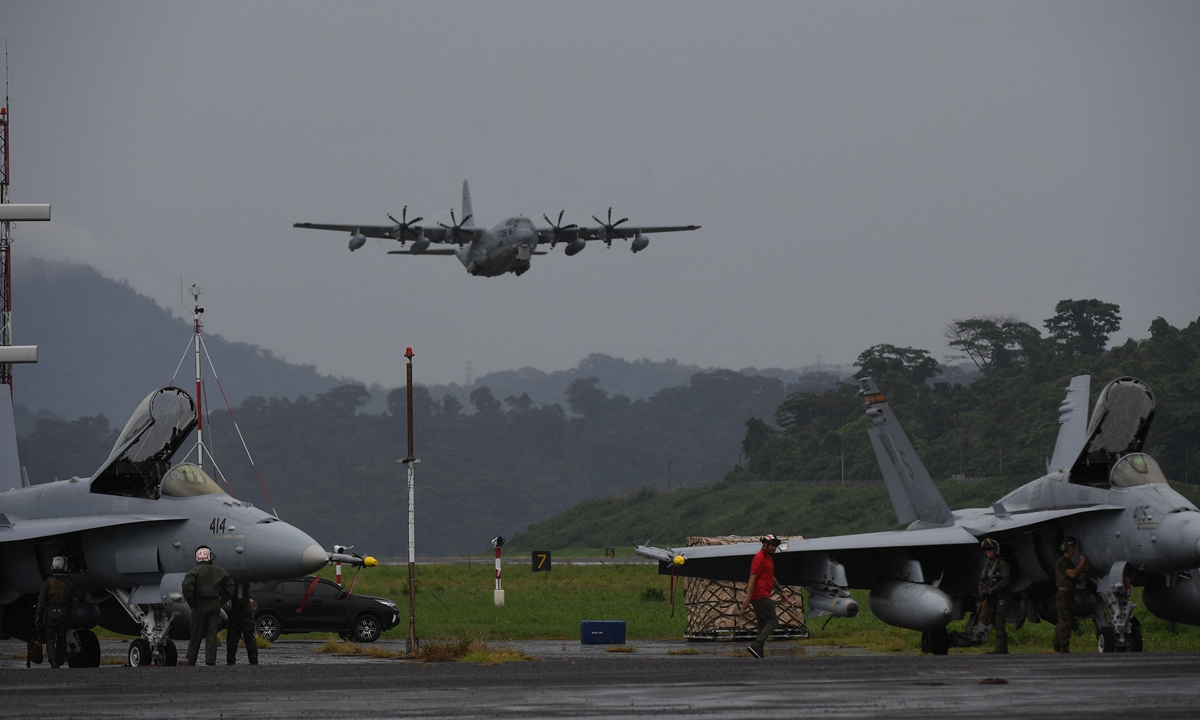The China Coast Guard expels Philippine vessels which had illegally intruded into waters adjacent to Ren'ai Jiao in China's Nansha Islands, on March 23, 2024. Photo: VCG
The Philippines has been making a show of the South China Sea issue for a long time. It has repeatedly provoked China and created tension in the South China Sea region while turning a blind eye to historical facts. Seemingly suffering from a sort of histrionic personality disorder, the Philippines has not only staged many farces on the issue, but also colluded with anti-China forces in the US-led West to play the thief crying "stop thief."
Last week, during his visit in the Philippines, US Secretary of State Antony Blinken reportedly "criticized China's provocative actions" in the South China Sea. Portraying the Philippines as a victim and China as a "perpetrator" has become a common intrigue to win attention and sympathy in the international community.
Supplying to its vessels illegally grounded on China's sovereign islands in the South China Sea is a trick of showmanship that the Philippines has employed in recent months. On Saturday, it sent a supply vessel and two coast guard vessels to intrude into the adjacent waters of China's Ren'ai Jiao (also known as Ren'ai Reef) in disregard of China's strong opposition.
"China's Coast Guard took necessary measures at sea in accordance with the law to safeguard China's rights, firmly obstructed the Philippine vessels, and foiled the Philippines' attempt," Chinese Foreign Ministry stated that same day.
Days earlier, Philippine civil group the Atin Ito coalition said it was planning another mission to the South China Sea with the aim of "delivering aid to fishermen" around China's Huangyan Dao (also known as Huangyan Island). According to Philippine media, the group openly claimed to mobilize "a delegation of international observers" to join their mission. It didn't seem to mind making the involvement of Western forces public.
"What it's like on board an outnumbered Philippine ship facing down China's push to dominate the South China Sea (CNN, March 26)," "China coast guard flexes its might against the Philippines in disputed waters as journalists look on (The Economic Times, March 27)"… It's not exaggeration to say that most media stories that smear China on the South China Sea issue, whether by Philippine or Western media, are products of the collusion between the anti-China forces of the Philippines and the US-led West.
The Global Times has looked into some of the various collusion forms, trying to reveal what's behind the current numerous untrue and misleading "media reports" that one-sidedly support the Philippines and attack China.

People protest with signs and placards on Mendiola Street against the visit of US Secretary of State Antony Blinken to the Philippines in Manila, on March 19, 2024. Photo: VCG
Closely linked Philippine coast guard, 'civil groups,' and US scholars
The Atin Ito coalition disclosed its new "supply mission" plan at an event it held in Manila on March 14. The event gathered senior officers from the Philippine military and government, and representatives from the British, Australian, Dutch, Swedish, and European Union embassies, local media Palawan News reported the following day.
The guest list implied that Atin Ito has never been an ordinary "civil group." Close sources told the Global Times that the group was led by Risa Hontiveros, an anti-China senator who once asserted raising the notorious 2016 South China Sea "arbitration" to the United Nations General Assembly. Last winter, Hontiveros planned a "Christmas supply" mission for Atin Ito, asking the group members to send food and goods to a military vessel "stationed" at Ren'ai Jiao with the help of the Philippine Coast Guard (PCG).
Atin Ito had tried to land on Huangyan Dao and plant the Philippines flag on the island in June 2016. According to the Philippine Daily Inquirer, a US scholar Anders Corr was among the group's activists aboard the fishing boat that intruded into the adjacent waters of the island.
All the information has reflected that the so-called "civil groups" resupplying Huangyan Dao and Ren'ai Jiao are "nothing but a farce jointly planned by a few Philippine politicians and military, as well as the anti-China forces in the US-led West," Yang Xiao, deputy director of the Institute of Maritime Strategy Studies, China Institute of Contemporary International Relations, told the Global Times.
In an article published on March 6, The Associated Press (AP) introduced a PCG strategy of publicizing "aggressive actions" by China in the South China Sea, which aims to "spark international condemnation that has put Beijing under the spotlight." This strategy is known as "offensive transparency."
"We will continue [with the strategy]," PCG spokesperson Commodore Jay Tarriela said in February.
Joining the PCG in 2005, Tarriela allegedly has numerous links with the US. In 2021, he was largely involved in bilateral US-Philippine collaboration, including in the Pacific Forum's US-Philippines' Next Generation Leaders Initiative, a project sponsored by the US Department of State, through the US Embassy in Manila.
According to an article by The Philippine Star in December 2023, Tarriela was considered a representative of the "pro-American faction," and even faced "CIA agent" accusations on social media.
Raymond Powell is another name frequently mentioned in the Philippines' "offensive transparency" strategy.
A retired US colonel, Powell is the founder of the security think tank Project Sealight, and leads the "Project Myoushu" at Stanford University in cooperation with the PCG and some Philippine Foreign Ministry officials.
The main purpose of the project is to support the "offensive transparency" strategy and help create a "victim" image for the Philippines on the South China Sea issue.

A US Air Force C-130 cargo plane comes in for a landing past US marines F/A-18 Hornet fighter jets during the semi-annual Philippine-US military exercise at the airport of the former US naval base in Manila, the Philippines, on July 13, 2023. Photo: VCG
US journalists invited on board
On March 5, two supply vessels and two coast guard vessels from the Philippines, illegally intruded into the adjacent waters of Ren'ai Jiao of China's Nansha Qundao, in an attempt to send materials, including construction materials, to the vessel illegally grounded at Ren'ai Jiao. The China Coast Guard took strict regulatory action to curtail the Philippine vessels' intrusion.
It is worth noting that the Philippines' mission included journalists from CNN, who said they witnessed a "high-stakes confrontation" that day, and wrote features that described their experiences on board in detail.
The CNN reporters wrote it was "the first time foreign journalists have been allowed to embed with the fleet in decades." But in fact, more than 10 years ago, US media reporters had boarded Philippine official vessels, including supply vessels, and wrote distorted media reports based on their first-hand experiences.
Early in 2013, The New York Times reporter Jeff Himmelman had been to the "Sierra Madre" vessel illegally grounded at Ren'ai Jiao for an interview, and later described the confrontation between China and the Philippines at South China Sea as "a game of shark and minnow" in a feature story.
Himmelman revealed that before they arrived they had "already hooked things up" with the local officials and the Filipino Navy.
In recent years, US journalists have been frequently invited on Philippine ships to participate in the PCG's "missions." In 2023 alone, two AP reporters and several other media staffers were invited aboard three PCG vessels that protect supply ships in November. In April 2023 the PCG reportedly invited many journalists, including those from the AP, to join a 1,670-kilometer "patrol."
According to a Chinese correspondent who worked in the Philippines for many years, there is a large number of US journalists in the Philippines. The Philippine authorities maintain close contact with foreign journalists in the country, and therefore, "it is easy for the authorities to seek cooperation from US journalists," said the correspondent who spoke on condition of anonymity.
The PCG's purpose of inviting journalists on board is to deliberately amplify the possible "incidents" through media, and to launch defamation warfare against China, the correspondent told the Global Times. "But I think [directly taking CNN reporters on board the PCG vessels] is excessive, and is even a sort of 'dishonor to the country,'" the correspondent added. "There is resentment within the Philippines, too."
US-funded Philippine media
Searching online media coverage on the South China Sea, one may find that Philippine and US media outlets are particularly close. They quote and forward each other's South China Sea stories, working closely together in attacking China on this topic.
Some of the major Philippine media outlets that are active in reporting on South China Sea include Rappler, VeraFiles, and the Philippine Center for Investigative Journalism.
Having called themselves "independent", these media outlets turn out to be are reportedly funded by the CIA and the US' infamous National Endowment for Democracy (NED).
In 2019, journalists from the aforementioned three media outlets were accused of receiving payments from the CIA, "a potential criminal offense under local law." The accusations claimed that the CIA uses the NED to channel funds, and the three media outlets "receive substantial grants from the NED," said the organization Committee to Protect Journalists in May that year.
VeraFiles, for instance, started receiving funds from the NED since 2016.
The NED website shows that, so far VeraFiles has got five batches of money from this US government-backed foundation, totally $350,600. It's far from a small amount for a media outlet without full-time reporters (only three editors and two web technicians). But VeraFiles has never disclosed how it spent the money.
Obviously, the Philippines has deeply colluded with the US government, think tanks, and media from top to bottom in "sadfishing" itself and demonizing China on the South China Sea issue. Worse still, such a nasty trick by the Philippines may become normal and diversified in the future, said Chen Xiangmiao, director of the World Navy Research Center at the National Institute for South China Sea Studies.
In response to the slander, Chen suggested China fight back with strong facts including on-site images, videos, and objective data. "We should make it clear to the international community what China's claims are in the South China Sea," Chen told the Global Times. "Do not let the US and the Philippines skew international public opinion."


No comments:
Post a Comment